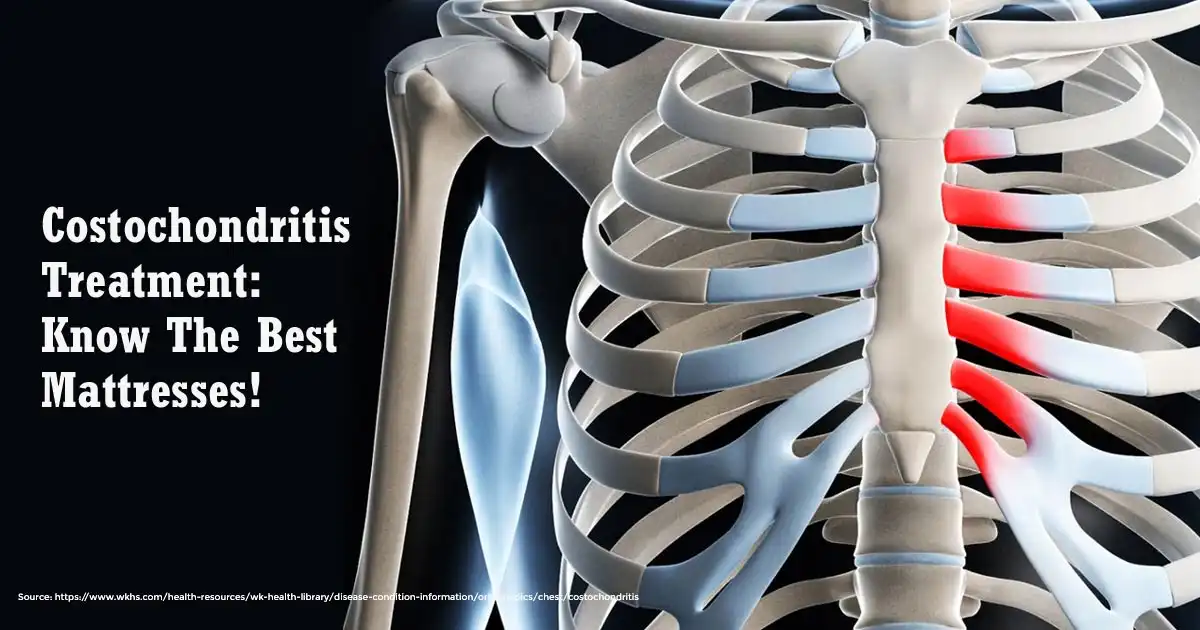Costochondritis Treatment: Know the Best Mattresses!

I’ve seen an increase in chest discomfort recently. It is not related to heart problems or lung infections.
Do you feel the same? This is called costochondritis.
Costochondritis affects the cartilage that connects the ribs to the sternum. It produces discomfort. This can resemble a heart attack.
The kind of mattress I slept on had an impact on my comfort. Hence, choosing a proper mattress makes a big difference.
Come along as I explore the top mattresses for costochondritis. Keep reading!
Is Costochondritis Dangerous?
Costochondritis is not dangerous. It is the inflammation that joins your ribs to your sternum. It can seem like a heart attack. So, I know it might be frightening because the pain can be really severe. But generally speaking, it disappears on its own without medical intervention.
Therefore, although it’s crucial to rule out other causes of chest pain, costochondritis itself shouldn’t cause you undue concern.
A good mattress can make a huge difference. Let us explore some of the best mattresses that can ease your pain! Have a look below!
Best Mattresses for Costochondritis: Top Picks
- PlushBeds Botanical Bliss – Best Mattress for Back Pain
- Purple Mattress – Best Mattress for Pressure Relief
- Tempur-Pedic Cloud– Best for Breathable Design and Good Pressure Relief
- Leesa Original Hybrid Mattress– Best in-Class Mattress
- Casper Snow Hybrid Mattress-Best Mattress for Spinal Alignment
5 Best Mattresses for Costochondritis: Shopping Guide!
1. PlushBeds Botanical Bliss

Mattress Type: Latex
Firmness: Medium/Medium-Firm
Warranty Period: Lifetime
Trial Period: 100 Night
Shipping: Free
Features:
- The mattress is crafted with GOTS certified organic cotton, wool, and latex. It ensures a chemical-free sleep environment.
- The natural latex layers provide good pressure relief for shoulders, hips, and joints. This helps to alleviate discomfort associated with costochondritis back pain.
- The dense organic latex core offers good support for your spine and body. It promotes proper alignment and reduces strain on sensitive areas.
- The combination of organic wool and latex helps to wick away moisture. This regulates body temperature, creating a cool and comfortable sleep surface.
- All-natural materials make the Botanical Bliss mattress suitable for allergy sufferers. It resists dust mites, mold, and other allergens.
- The high-quality organic latex core ensures long-lasting support and resilience.
For more information, read the detailed review of Plushbed Botanical Bliss!
2. Purple Mattress
Mattress Type: Foam
Firmness: Medium-Firm
Warranty Period: 10 Year
Trial Period: 100 Night
Shipping: Free
Features:
- GelFlex® Grid in the top layer provides instant cooling comfort and pressure relief. It reduces pain points like those associated with costochondritis.
- The open-cell structure of the GelFlex® Grid promotes airflow. It prevents heat buildup and creating a cooler sleep environment.
- The GelFlex®Grid conforms to your body shape. It relieves pressure points and reduces discomfort, including pain related to costochondritis.
- The base support foam ensures proper spinal alignment. It helps to alleviate tension and discomfort in the chest and rib area. This can be exacerbated by costochondritis.
- Minimal disturbance to your sleep partner, allowing for uninterrupted rest.
- Suitable for allergy sufferers, providing a clean and healthy sleep environment.
- Prevents sinkage, making it easier to get in and out of bed.
Curious to know more? Head on to our Purple Mattress review!
3. Tempur-Pedic Cloud
Mattress Type: Foam
Firmness: Medium/Medium Hybrid
Warranty Period: 10 Year
Trial Period: 90 Night
Shipping: Free
Features:
- Tempur® Material provides instant, cloud-like comfort and pressure relief. It reduces pain points like those associated with costochondritis. It is an important part of costochondritis treatment.
- The mattress conforms to your body shape, evenly distributing weight and reducing pressure points. This can help alleviate discomfort in the chest and rib area.
- Minimal disturbance from a sleep partner, allowing for uninterrupted rest.
- Helps regulate body temperature, preventing overheating and discomfort.
- While the 360° stretch cover is soft, the underlying layers provide the necessary support to maintain proper spinal alignment. It can help alleviate tension in the chest area.
- Prevents sinkage, making it easier to get in and out of bed.
For more information, read our Tempur-Pedic Cloud Mattress review!
4. Leesa Original Hybrid Mattress
Mattress Type: Hybrid
Firmness: Medium to Medium-Firm
Warranty Period: 10 Year
Trial Period: 100 Night
Shipping: Free
Features:
- The mattress combines supportive innerspring coils and cooling memory foam.
- It adapts to your body shape, relieving pressure points and reducing discomfort. It is especially in the chest and rib areas affected by costochondritis.
- Leesa Original Hybrid provides targeted support for the lower back. It helps alleviate tension and discomfort that can radiate to the chest.
- The memory foam recovery layer promotes airflow and heat dissipation. It creates a cooler sleep environment. This can be beneficial for those experiencing chest discomfort.
- Prevents sinkage, making it easier to get in and out of bed without added strain on the chest.
Read our Leesa Original Hybrid Mattress review!
5. Casper Snow Hybrid Mattress
Mattress Type: Hybrid
Firmness: Medium
Warranty Period: 10 Year
Trial Period: 100 Night
Shipping: Free
Features:
- Snow cover in the top layer helps regulate body temperature. It prevents heat buildup and discomfort, which can be aggravated by costochondritis.
- 3-zoned support system provides targeted support for different body areas. It includes the back and shoulders. This helps to alleviate tension and reduce costochondritis back pain.
- Responsive coils offer bounce and support while providing pressure relief. It helps to align the spine and reduce strain on the chest.
- 3-3 Heat Delete Bands act as a thermal highway. It removes excess heat.
Eager to know more? Have a look at our Casper Snow Hybrid Mattress review!
Costochondritis can be a real mystery for both doctors and patients. Its cause is often hard to find. However, based on my experience, there are several potential triggers that might lead to this condition. Let’s discuss it!
Costochondritis Causes

Chest Infection
- One of the common causes is infections in the chest.
- These infections can inflame the cartilage connecting your ribs to your breastbone.
- Additionally, repeated minor trauma to your chest wall can contribute to costochondritis.
Excessive Coughing or Vomiting
- Another factor is excessive coughing or vomiting.
- It might not seem like a big deal, but coughing or vomiting too hard can strain the chest area. It leads to inflammation.
- Intense physical activities can also be culprits. This includes working out vigorously or playing sports without allowing your body to recuperate. This can affect costochondritis treatment.
Excess Physical Activity
- Physical activities that are out of the ordinary for you may cause costochondritis.
- For instance, increasing the intensity of your workout too quickly or engaging in activities like moving heavy furniture.
- This can put unexpected stress on your chest.
Inflammatory Diseases
- Inflammatory diseases that affect your joints and spine, such as arthritis, can be linked to costochondritis.
- Conditions like osteoarthritis, rheumatoid arthritis, and ankylosing spondylitis can cause inflammation in your cartilage.
Tumors
- In rare cases, tumors can be the cause.
- These tumors can migrate from joints or other parts of the body and settle in the chest area, causing inflammation.
Lastly, the use of IV drugs has been associated with the development of this condition. If you know these potential triggers, you can manage and prevent costochondritis. If you think any of these factors, it’s always a good idea to discuss them with your healthcare provider.
When it comes to costochondritis, the pain can be quite intense. Here’s what you might experience:
Costochondritis Symptoms
Costochondritis Pain Locations
- Chest Pain: Typically, you’ll feel pain in your chest area.
- Left-Side Concentration: The pain often centers on the left side of your breastbone.
- Pain Nature: It can feel sharp, aching, or like pressure on your chest.
- Multiple Ribs: More than one rib may be affected.
- Radiation to Arms and Shoulders: Sometimes, the pain can spread to your arms and shoulders.
Aggravating Factors: The pain might worsen when you:
- Take a deep breath, cough, sneeze, or vomit
- Twist or stretch your trunk muscles
- Hug someone
- Exercise or lie down on the affected side
Common Infection Symptoms
Costochondritis itself typically doesn’t cause infection symptoms. It’s important to distinguish it from Tietze syndrome. Symptoms of an infection to watch for include:
- Redness
- Swelling
- Heat at the affected rib
Duration of Costochondritis
The duration of costochondritis can vary:
- Typical Duration: Most symptoms last from a few days to a few weeks. This happens in the case of costochondritis anxiety.
- Rare Cases: In some instances, the symptoms may persist for several months.
When to Call a Doctor?
There are certain signs that indicate you should reach out to your doctor:
- Breathing Difficulties
- Fever
- Infection Symptoms
- Persistent or Worsening Pain Despite Medication
- Nausea
- Sweating
- Dizziness
Certain symptoms should prompt you to go to the emergency room. They could indicate more serious conditions. Especially if it doesn’t improve with medications like acetaminophen or ibuprofen.
Some groups of people are at a higher risk of developing costochondritis. They are athletes, those whose jobs require significant physical effort, and people above the age of 40-50.
Knowing the symptoms and knowing when to seek medical help is crucial. Always keep an eye on how your body responds. Don’t hesitate to consult a doctor if the pain persists or worsens.
For more information on costochondritis, read on!
I have cured costochondritis on my own. I want to share these measures with you. Have a look!
How I Cured My Costochondritis?
Costochondritis Self-Care
Topical Pain Relievers:
- Creams, gels, patches, and sprays can be beneficial.
- These products often contain nonsteroidal anti-inflammatory drugs or numbing agents.
- Some even have capsaicin, the ingredient that gives hot peppers their heat, which can help reduce pain.
Heat or Ice:
- Applying a hot compress or heating pad to the painful area several times a day has been soothing for me.
- It’s important to keep the heat setting low to avoid burns.
- Ice packs can also be quite effective in reducing pain and inflammation.
- Costochondritis physical therapy helps to deal with this.
Rest:
- Modifying or avoiding activities that aggravate the pain is crucial.
- I’ve learned to listen to my body and take it easy when the pain flares up.
These measures have helped me manage the discomfort. I hope you find these tips as useful as I have.
FAQs on Costochondritis
- What helps costochondritis go away?
Costochondritis typically resolves on its own within a few days to weeks. Though in some cases it can take several months. Applying heat or cold to the affected area can provide relief. Avoiding activities that aggravate the pain is essential for recovery.
Using creams, gels, patches, or sprays with anti-inflammatory or numbing ingredients can also help manage discomfort.
- What does costochondritis feel like?
Costochondritis often presents as a dull ache in the chest. It is typically around the affected ribs. The discomfort can intensify and feel sharp or stabbing, especially with movements involving your chest or torso. Certain actions, such as deep breathing or heavy breathing, can exacerbate the pain.
- What should I avoid with costochondritis?
To manage costochondritis effectively, it’s important to avoid activities that put extra strain on your chest area. This includes avoiding strenuous exercise and repetitive movements. Any action that intensifies your chest discomfort should be adjusted. Costochondritis exercises may help.
- Can costochondritis be caused by stress?
While chest pain from anxiety can feel similar, it’s usually attributed to other underlying issues rather than costochondritis. Although costochondritis can arise from activities that strain the chest area, there’s no evidence linking it directly to emotional stress.
- What foods can trigger costochondritis?
Acidic foods like tomatoes, orange and grapefruit juice, and tomato sauce can aggravate costochondritis. Foods that are fried can be major culprits in causing inflammation. Some people with costochondritis find that dairy products can worsen their symptoms. Additionally, processed foods often contain additives that can contribute to inflammation.
